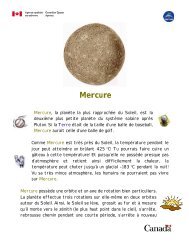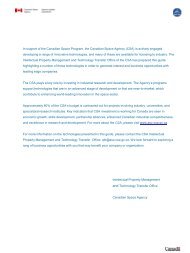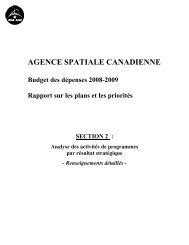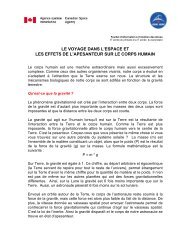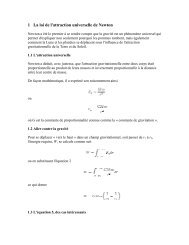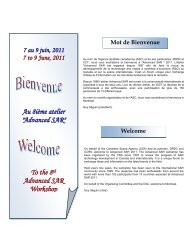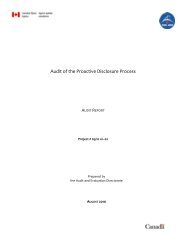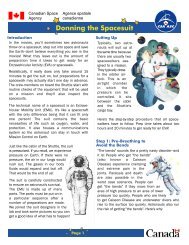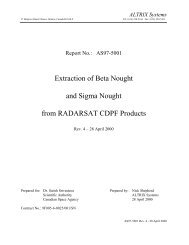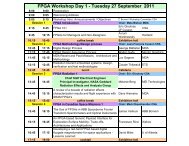PDF version of COSPAR - Space Science Research in Canada Report
PDF version of COSPAR - Space Science Research in Canada Report
PDF version of COSPAR - Space Science Research in Canada Report
Create successful ePaper yourself
Turn your PDF publications into a flip-book with our unique Google optimized e-Paper software.
<strong>of</strong> water on Mars is a scientific priority because <strong>of</strong> its relevance to the question <strong>of</strong>whether the planet ever supported life.Gellert was part <strong>of</strong> scientific team at Germany’s Max Planck Institute forChemistry that built similar <strong>in</strong>struments for the Pathf<strong>in</strong>der mission that landed onMars <strong>in</strong> 1997, and the two NASA Mars Exploration Rovers (MER), Spirit andOpportunity, that landed <strong>in</strong> January, 2004, and are still explor<strong>in</strong>g Mars. However,<strong>in</strong> 2004, Gellert found out that his department was be<strong>in</strong>g closed, so he beganlook<strong>in</strong>g for a new <strong>in</strong>stitution where he could cont<strong>in</strong>ue development <strong>of</strong> APXS forfuture planetary missions.That turned out to be the University <strong>of</strong> Guelph, <strong>in</strong> large part through the efforts <strong>of</strong>Ia<strong>in</strong> Campbell, a Guelph scientist with whom Gellert had already collaborated.Campbell runs a facility called PIXE (proton-<strong>in</strong>duced x-ray emission) that uses atechnique similar to that employed by APXS.The Canadian <strong>Space</strong> Agency agreed to fund Gellert’s research and is support<strong>in</strong>gdevelopment <strong>of</strong> APXS for the MSL mission, one <strong>of</strong> only ten <strong>in</strong>struments selectedby NASA <strong>in</strong> an <strong>in</strong>ternational competition. “This was an excit<strong>in</strong>g opportunity,” saidVicky Hipk<strong>in</strong>, CSA’s Program Scientist for Planetary Exploration. “When a bigmission like this comes along, it’s a very rare opportunity for Canadianscientists.”Because <strong>of</strong> the orbital positions <strong>of</strong> the planets, missions to Mars can only belaunched every two years, and relatively few are open to <strong>in</strong>ternationalcompetition. “<strong>Canada</strong> has taken a strategic decision not to have its own launchcapability so this makes us very much <strong>in</strong> favour <strong>of</strong> <strong>in</strong>ternational collaboration andit makes us a good partner to other agencies,” Hipk<strong>in</strong> said.MSL will be the largest rover ever sent to Mars, and it will carry the mostadvanced set <strong>of</strong> <strong>in</strong>struments to date. The APXS <strong>in</strong>strument on this mission, forexample, works five times faster than its predecessor on the MER rovers.The primary goal is to determ<strong>in</strong>e whether the environment on Mars is, or everwas, capable <strong>of</strong> support<strong>in</strong>g microbial life. Accord<strong>in</strong>g to NASA, <strong>in</strong>vestigat<strong>in</strong>g thepast habitability <strong>of</strong> Mars gives the scientific community “a better understand<strong>in</strong>g <strong>of</strong>whether life could have existed on the Red Planet and, if it could have existed, anidea <strong>of</strong> where to look for it <strong>in</strong> the future.”One important way <strong>of</strong> do<strong>in</strong>g this is to study rocks and soils, which conta<strong>in</strong> an<strong>in</strong>valuable record <strong>of</strong> Mars’ geological and climatic past. Scientists know that Marsonce had a considerable amount <strong>of</strong> liquid water on its surface and that it currently40



